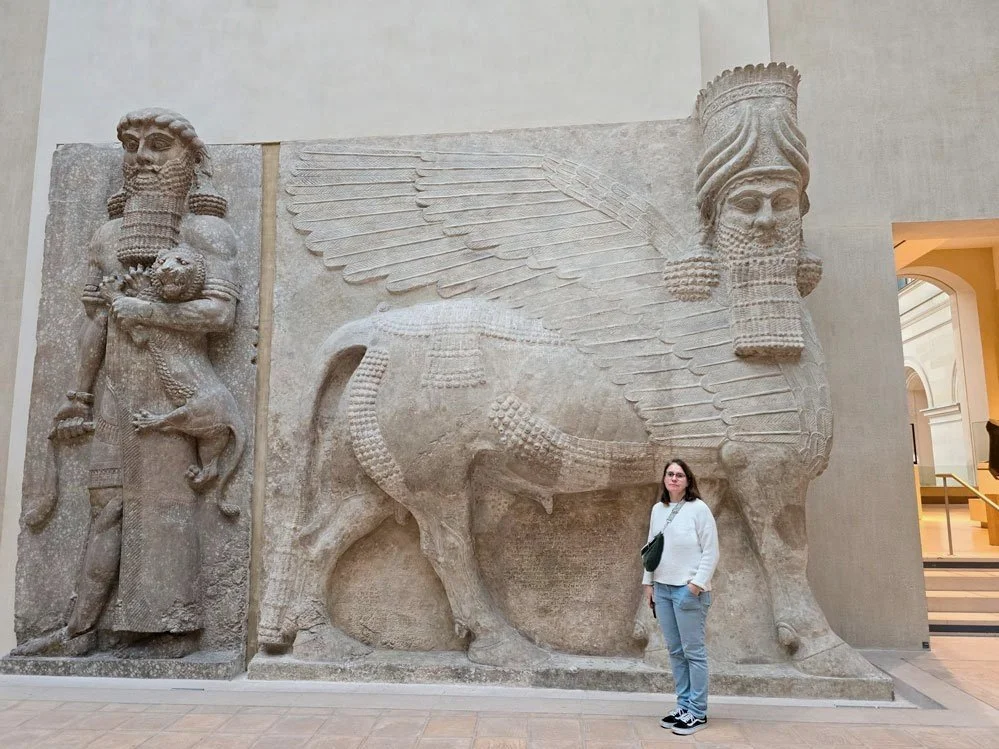
Hand-drawn lamassu
*
Hand-drawn lamassu *

Historical Context
The Lamassu is an iconic figure of Mesopotamian mythology, originating from the Assyrian and Babylonian civilizations between the 9th and 7th centuries BCE. These majestic hybrid creatures—featuring the body of a bull or lion, wings of an eagle, and a human head—symbolized protection, power, and divine authority.
Function and Meaning
The Lamassu served as protective deities, standing guard at the entrances of temples and palaces. Their primary purpose was both spiritual and political:
Spiritual Role: They warded off evil spirits and protected the inhabitants of the structure.
Political Role: As symbols of strength and authority, they projected the power of the Assyrian kings over both terrestrial and celestial realms.
Inscriptions carved alongside the Lamassu often invoked divine curses upon those who dared harm the structure or its owner, emphasizing their sacred and protective function.

Artistic Features
The artistry of the Lamassu demonstrates the ingenuity of Mesopotamian sculptors, blending realism with symbolic elements:
Detailed Craftsmanship: The intricate curls of the beard, the feathers of the wings, and the musculature of the body showcase the meticulous work of ancient artisans.
Perspective Innovation: Many Lamassu have five legs, allowing them to appear static and authoritative from the front but in motion when viewed from the side—an innovative technique for its time.

Félix Thomas, 1853, Visit of the Pasha of Mosul to Khorsabad, Public Domain. This painting by Félix Thomas captures the historical rediscovery of Lamassu and other Assyrian artifacts in the mid-19th century. Such artworks highlight the enduring significance of these sites.
Historical Sites in Iraq
Lamassu sculptures were prominently featured in the palaces of major Assyrian cities such as Nimrud, Khorsabad, and Nineveh, located in present-day northern Iraq. Key examples include:
Nimrud: The Lamassu from the Northwest Palace of Ashurnasirpal II, a site renowned for its artistic and architectural splendor.
Khorsabad (Dur-Sharrukin): The palace of Sargon II featured colossal Lamassu, some standing over 4 meters tall, guarding its grand entrances.
Nineveh: The South-West Palace of Sennacherib housed impressive Lamassu, marking the city as the heart of the Assyrian Empire.
Though many Lamassu remain in these archaeological sites, some have been relocated to museums, such as the Louvre, the British Museum, and the Iraq Museum in Baghdad. Tragically, others have been destroyed or damaged during conflicts.

Artistic Process Description for the Lamassu Drawing
This Lamassu illustration is meticulously hand-drawn using traditional graphite pencils, showcasing a deep commitment to precision and detail. By skillfully combining different pencil types, such as 2H for lighter lines and 2B for deeper, richer tones, the drawing achieves a striking contrast that enhances the depth and texture of the piece.
To create smooth transitions and emphasize the intricate shading, I use blending techniques with tools like blending stumps or tissues. This approach allows me to soften the edges and highlight the delicate interplay of light and shadow, bringing the Lamassu's features to life.
Each stroke is carefully considered, from the finely detailed beard curls to the ornate headdress, capturing the timeless elegance and cultural significance of this iconic Mesopotamian figure. This process not only reflects my artistic style but also honors the ancient craftsmanship that inspires my work.

The Fragility of the Lamassu: The 2015 Destruction by Daesh in Mosul
In 2015, during their occupation of Mosul, Iraq, the terrorist group Daesh (ISIS) carried out the systematic destruction of priceless cultural heritage. Among the targeted artifacts were the ancient Lamassu sculptures, which had stood as guardians of Mesopotamian culture for millennia.
At the Mosul Museum, Daesh militants used sledgehammers, drills, and explosives to obliterate these iconic sculptures, claiming to fight idolatry. These acts were not only a tragic loss of irreplaceable historical treasures but also a calculated attempt to erase the cultural identity of the region.
The destruction of the Lamassu became a symbol of the fragility of cultural heritage in conflict zones, underscoring the urgent need for global efforts to protect and preserve such artifacts.
AFP

Good New ! Unearthing the 2,700-Year-Old Lamassu: A Testament to Mesopotamian Heritage Preservation
In October 2023, a Franco-Iraqi archaeological team unearthed a remarkable 2,700-year-old Lamassu statue in Khorsabad, near Mosul, Iraq. This monumental sculpture, weighing approximately 18 tons and measuring 3.8 by 3.9 meters, originally stood at the entrance of the ancient city during the reign of King Sargon II (722–705 BCE).
The Lamassu, a mythological creature with a human head, the body of a bull or lion, and bird wings, served as a protective deity in ancient Mesopotamian culture, often placed at city gates or palace entrances to ward off evil.
In the 1990s, the statue's head was removed by looters but was later recovered and is now housed in the Iraq Museum in Baghdad. To safeguard the remaining structure from potential threats, local villagers buried the Lamassu, effectively preserving it through periods of conflict, including the destructive campaigns by ISIS in 2014.
The recent excavation not only highlights the rich cultural heritage of the region but also underscores the resilience and dedication of local communities in preserving their history, even amidst adversity. The successful unearthing and planned restoration of the Lamassu stand as a testament to the collaborative efforts in safeguarding and celebrating our shared human past.
For a detailed scientific analysis of this discovery, you can refer to the publication by The Archaeologist.
Excavation of a 2,700-Year-Old Assyrian Lamassu in Khorsabad – Rediscovering Mesopotamian Heritage. Photo credits: Mustafa Faraj






